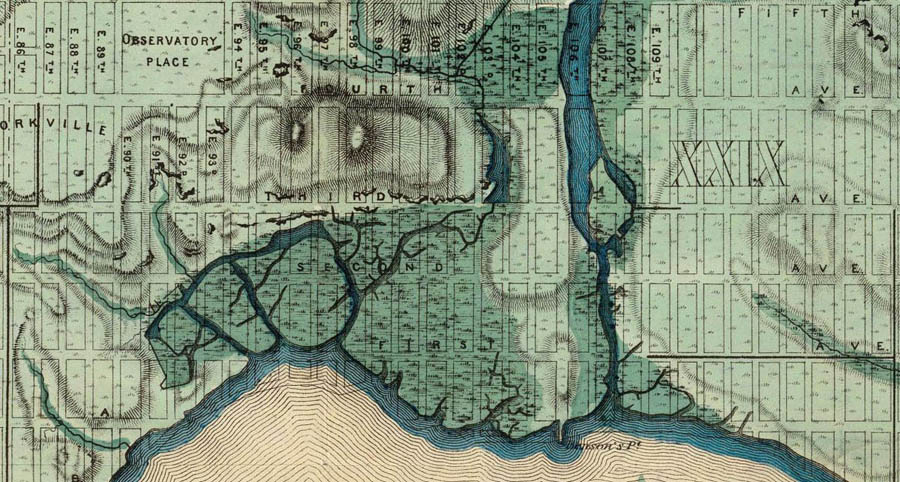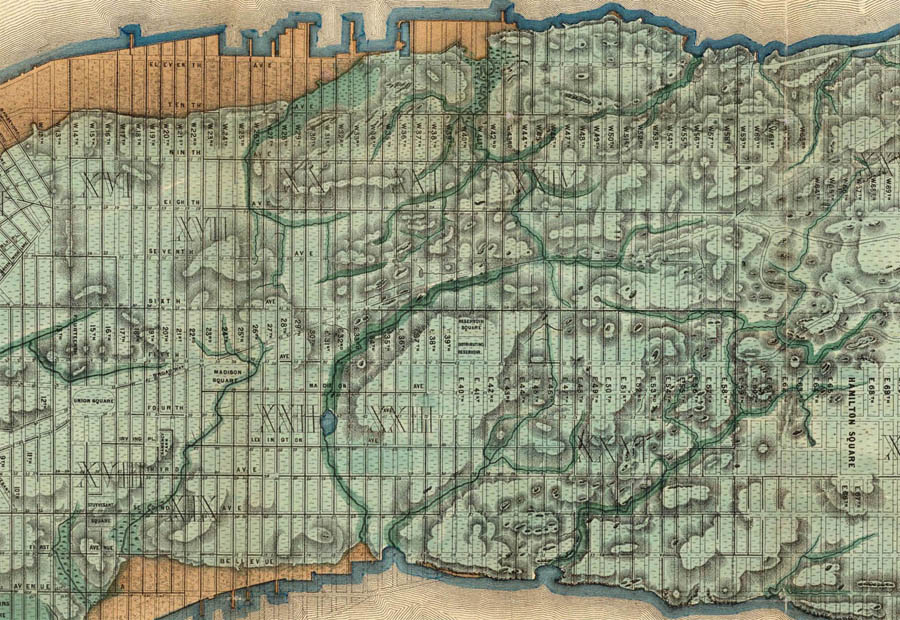 [Image: The Viele Map].
[Image: The Viele Map].
Because of a talk I’ll be giving tonight at the USC School of Architecture with Nicola Twilley of Edible Geography, I found myself re-reading an old post here about fishing in the basements of Manhattan.
 [Image: The Viele Map].
[Image: The Viele Map].
Manhattan being an island once thoroughly criss-crossed by ponds and streams, almost all of which have been sealed in concrete and turned into sewers, this somewhat hallucinatory theory goes that some of those streams might still be accessible: just smash down through your building’s basement floor, uncover the island’s lost hydrology of well-braided rivers and streams, and an angling paradise will be accessible at your feet.
 [Image: The Viele Map via Kottke.org].
[Image: The Viele Map via Kottke.org].
But what really caught my eye, and what I’m actually posting about here, is a “gutterspace” reclamation project inaugurated by a man named Jack Gasnick, something I rediscovered today after following a link at the end of that post, which leads to the long-defunct blog Urbablurb by Giles Anthony.
 [Image: From Gordon Matta-Clark’s Fake Estates, via Free Association Design].
[Image: From Gordon Matta-Clark’s Fake Estates, via Free Association Design].
This is how Anthony describes Gasnick’s project:
In the early 1970s—unbelievably, given how influential Gordon Matta-Clark has become in the last few years—Gasnick began buying and collecting “gutterspace,” or small slivers of land left over from zoning or surveying errors. He said that after a little while he couldn’t stop: “It’s like collecting stamps; once you’ve got the fever, you’ve got the fever.”
Accordingly, Gasnick “bought a slice in Corona just behind Louis Armstrong’s house,” Urbablurb continues, “a piece near Jamaica Bay where he once filled a pail with sea-horses, and yet another adjacent to the Fresh Kills landfill where he claims an abandoned sea Captain’s house still stood.” Gasnick then cultivated small patches of parkland and wilderness within those areas—a micro-wilding of the metropolis, one site at a time: “On the weekends, he would sometimes drive out to the tiny parcels and help the milkweed and laurel grow, tend to the turtles, and sit down for a picnic. ‘This jump of mine from flower pot to apple tree bears witness to the fact that it doesn’t cost much for an apartment-living guy to get a share of the good environment,’ he wrote in 1974. To be exact, it cost between $50 and $250. But the taxes he had to pay were enough of a hassle that he gave away (or otherwise lost track of) all the pieces by 1977.”
He “lost track” of them—the mind reels at the possibility that there is still a distributed Jack Gasnick estate somewhere, peppering the streets and gutters of New York City.
As Anthony suggests, this all has an uncanny parallel in Gordon Matta-Clark’s Fake Estates project. From Cabinet magazine:
In the early 1970s, Matta-Clark discovered that the City of New York periodically auctioned off “gutterspace”—unusably small slivers of land sliced from the city grid through anomalies in surveying, zoning, and public-works expansion. He purchased fifteen of these lots, fourteen in Queens and one in Staten Island. Over the next years, he collected the maps, deeds, and other bureaucratic documentation attached to the slivers; photographed, spoke, and wrote about them; and considered using them as sites for his unique brand of “anarchitectural” intervention into urban space.
So who is Jack Gasnick, that minor New Yorker who once “bought strange-shaped lots in every borough,” as the New York Times reported back in 1994, when Gasnick was still alive and 74 years old, and who once claimed to fish in the basements of Manhattan? Who knows.
(The BLDGBLOG/Edible Geography presentation tonight at USC is at 6pm in Harris Hall; it’s free and open to the public. We’ll be talking about buried rivers, artificial glaciers, and quarantine, among other shared topics of interest).

Very fascinating indeed! Regarding Manhattans topography etc., you might know this book: Mannahatta: A Natural History of New York City, by Eric W. Sanderson and Markley Boyer
Doesn't Portland, OR have that freakishly small park?
I've wondered about little parcels of land I see near the freeways here in San Francisco – how can I buy one?
what is the smallest tunnel you will explore?
do you know of special carts or running gaits for tunnels shorter than a person?